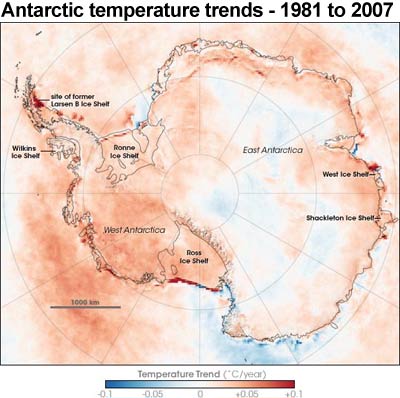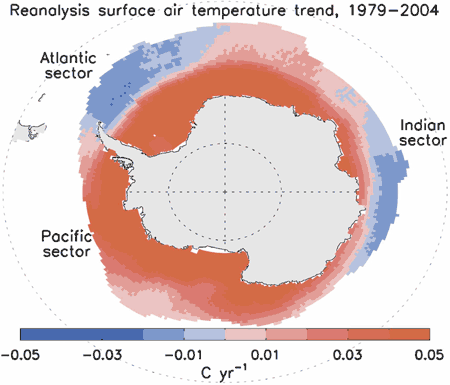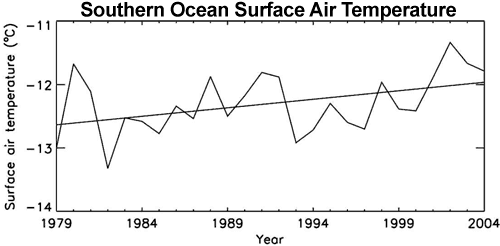Why is southern sea ice increasing?
What the science says...
| Select a level... |
 Basic
Basic
|
 Intermediate
Intermediate
| |||
|
Antarctic sea ice has been growing over the last few decades but it certainly is not due to cooling - the Southern Ocean has shown warming over same period. Increasing southern sea ice is due to a combination of complex phenomena including cyclonic winds around Antarctica and changes in ocean circulation. |
|||||
Climate Myth...
Southern sea ice is increasing
'Antarctic sea ice set a new record in October 2007, as photographs distributed by the National Oceanic and Atmospheric Administration showed penguins and other cold-weather creatures able to stand farther north on Southern Hemisphere sea ice than has ever been recorded. The news of expanding Antarctic sea ice stole headlines from global warming alarmists who asserted Arctic sea ice had reached its lowest extent since 1979.' (James Taylor)
The most common misconception regarding Antarctic sea ice is that sea ice is increasing because it's cooling around Antarctica. The reality is the Southern Ocean surrounding Antarctica has shown strong warming over the same period that sea ice has been increasing. Globally from 1955 to 1995, oceans have been warming at 0.1°C per decade. In contrast, the Southern Ocean (specifically the region where Antarctic sea ice forms) has been warming at 0.17°C per decade. Not only is the Southern Ocean warming, it's warming faster than the global trend. This warming trend is apparent in satellite measurements of temperature trends over Antarctica:

Figure 2: Antarctic surface temperatures as observed by satellites between 1981 and 2007.
Similar trends are found when combining temperature data measured from ships and buoys. The following figure from Increasing Antarctic Sea Ice under Warming Atmospheric and Oceanic Conditions (Zhang 2007) displays trends over the ice-covered Southern Ocean - this is the region where Antarctic sea ice forms.

Figure 3: Linear trend (1979–2004) of surface air temperature over the ice-covered areas of the Southern Ocean (Zhang 2007).
We see strong warming over most of the ice-covered Southern Ocean although there is also some cooling. What is the average trend over the whole region? The overall surface temperature trend over the ice-covered regions of the Southern Ocean shows a warming trend:

Figure 4: Annual mean surface air temperature averaged over the ice-covered areas of the Southern Ocean. Straight line is trend line (Zhang 2007).
Oceanographic data also find that the waters in the Southern Ocean are warming. The waters of the Southern Ocean's Antarctic Circumpolar Current have warmed more rapidly than the global ocean as a whole. From 1960 to 2000, water temperature increased by 0.068°C per decade at depths between 300 and 1000 metres. This warming trend has increased to 0.098°C per decade since the 1980s (Boning 2008).
If the Southern Ocean is warming, why is sea ice increasing? There are several contributing factors. One is the drop in ozone levels over Antarctica. The hole in the ozone layer above the South Pole has caused cooling in the stratosphere (Gillet 2003). A side-effect is a strengthening of the cyclonic winds that circle the Antarctic continent (Thompson 2002). The wind pushes sea ice around, creating areas of open water known as polynyas. More polynyas leads to increased sea ice production (Turner 2009).
Another contributor is changes in ocean circulation. The Southern Ocean consists of a layer of cold water near the surface and a layer of warmer water below. Water from the warmer layer rises up to the surface, melting sea ice. However, as air temperatures warm, the amount of rain and snowfall also increases. This freshens the surface waters, leading to a surface layer less dense than the saltier, warmer water below. The layers become more stratified and mix less. Less heat is transported upwards from the deeper, warmer layer. Hence less sea ice is melted (Zhang 2007).
Antarctic sea ice is complex and counter-intuitive. Despite warming waters, complicated factors unique to the Antarctic region have combined to increase sea ice production. The simplistic interpretation that it's caused by cooling is false.
Intermediate rebuttal written by John Cook
Update July 2015:
Here is a related lecture-video from Denial101x - Making Sense of Climate Science Denial
Last updated on 8 July 2015 by pattimer. View Archives































 Arguments
Arguments































How do the explanations in this article correspond to the 2008 paper by Corr and Vaughn in Nature Geoscience about volcanism affecting the Pine Island Glacier?
newtja, Corr & Vaughan (2008) does not attempt to assess or quantify the effect of volcanic venting on the Pine Island glacier. The eruption discussed occurred roughly 2k years ago. It's possible that venting is helping the break up of PI glacier, but as you can see from the article above, and from Shepherd et al. (2013), there are greater factors involved. You might also check out Vaughan & Corr (2012). Here are the last lines of their abstract:
"We conclude that ice-shelf basal melting plays a role in determining patterns of surface and basal crevassing. Increased delivery of warm ocean water into the sub-ice shelf cavity may therefore cause not only thinning but also structural weakening of the ice shelf, perhaps, as a prelude to eventual collapse."
For anybody who likes a relaxing assimilation of some information there's a lecture by Dr. Sarah Gille on the Antartctic ocean, apparently her specialty, on the web at time of my comment. Discusses the contraction that's happened causing cooler oceans near South Pole but warmer at slightly higher lataitudes. Also, a polar atmosphere lecture by Dr. Dan Lubin.
One connection is missing here. As the westerly winds increase, increasing the push on the sea ice, it increases the speed with which the ice is moving clockwise around the Antarctic. In the southern hemisphere, moving objects veer to the left. In a clockwise rotating system, left is away from the centre. This may be part of the explanation of why the ice is spreading outwards. We see this in the Bearfort gyre. It normally rotates clockwise and in the norther hemisphere, moving objects veer to the right. In a clockwise rotating system in the northern hemisphere, right is toward the centre and indeed, the centre of the Beaufort gyre, contary to one would think at first thought, is higer than the edges. Ocean garbage patches are also an example of this phenomenon.
Exactly why do we need this page when we already have one called "Antarctica is gaining ice"? It seems like that page covers pretty much the same topic as this one does.
[DB] This article deals specifically with sea ice in the vicinity of Antarctica. The other rebuttal deals with both land and sea-based ice.
Southern Ocean: Sea Ice Concentration and Sea Surface Temperature
Recently there has been a discussion about the link between SST and SIC in the Southern Ocean around Antarctica. It is claimed that there has been a drop in temperature in the Southern Ocean with a consequent increase in ice concentration. This is contrary to what you can read on the SKS. However, there are conflicting data.
If you use data from GISS, HADLEY or Berkeley, it seems that SST is growing in the Southern Ocean. If you are use data from NOAA you arrive at the opposite conclusion, namely that the SST is decreasing.
So there is a reconciliation issue between the different data sources. At present I have not found any discussions that shed light on the causes of this. NOAA, however, stresses a possible cause:
“The optimum interpolation (OI) sea surface temperature (SST) analysis is produced weekly on a one-degree grid. The analysis uses in situ and satellite SST's plus SST's simulated by sea-ice cover. Before the analysis is computed, the satellite data is adjusted for biases using the method of Reynolds (1988) and Reynolds and Marsico (1993).”
This means that you start with ice cover and then you simulate the SST and let this go into calculating the SST. In this way there will be a strong correlation between SST and SIC.
The following graph shows the development of SST around Antarctica (60S-90S) using data from NOAA monthy sst and sic
There is at strong correlation beween SST and SIC
My questions are:
Is the NOAA data a fact or an artifact?
Is this in general a story of bad data?
Klaus Flemløse @12.
What exactly is it you are hoping your last graph demonstrates? I recognise the first three of your graphs. I am not sure of the purpose of the fourth, which appears to be some spectral analysis.
But the last graph, and I may be mistaken, is plotting Antarctic SIA against SST (90S-60S) and in my book simply demonstrates that ice cover around Antarctica is greater when SST is lower, ie during the Antarctic winter.
Antarctica
I have a good question with respect to sea temperature and sea ice: Who leads who?
It is commonly accepted that there is a feedback between temperature and sea ice. It can go both ways:
1) Lower temperature causes more sea ice
2) More sea ice causes lower temperature.
In the skeptical sphere they believe that 1) is valid.
However, it is a little more complicated, which is explained in the following article from 1991 by John W. Weatherly :
Antarctic Sea ice variations and seasonal air temperature relationships
ABSTRACT Data through 1987 are used to determine the regional and seasonal dependencies of recent trends of Antarctic temperature and sea ice. Lead-lag relationships involving regional sea ice and air temperature are systematically evaluated, with an eye toward the ice-temperature feedbacks that may influence climatic change. Over the 1958-1087 period the temperature trends are positive in all seasons. For the 15 years (l973-l987) for which ice data are available, the trends are predominantly positive only in winter and summer, and are most strongly positive over the Antarctic Peninsula. The spatially aggregated trend of temperature for this latter period is small but positive, while the corresponding trend of ice coverage is small but negative. Lag correlations between seasonal anomalies of the two variables are generally stronger with ice lagging the summer temperatures and with ice leading the winter temperatures. The implication is that summer temperatures predispose the near-surface waters to above-or below-normal ice coverage in the following fall and winter.
This means that in the summer the temperature leads the sea ice and in the winter the sea ice leads the temperature.
Question: Does there exist an updated confirmation of this?
@12
I have tried to include a discontinuity at September 2006 in the sea surface temperature(sst):
In this case the fit is better and the SST is increasing, but not significantly. Is the discontinuity comming from an error in sea ice cover data?
Can someone tell me if there is a know error in NOAA data around 2005-2010 ?
What am I going to believe?
LINK
[RH] Need to keep the width of the images limited or they break the page formatting. I added a zoom so you can see the details (or at least I thought I did). Edit: Okay, next best thing is an added link to the full sized image. ;-)
Klaus Flemløse @15.
If you look at narrower bands of latitude, the "step function" you have identified occurs between 70ºS and 55ºS. Another feature of such analysis is the decreasing interannual variation with increasing latitude. The variation is strongly linked to ENSO. I would guess most of the "step function" is actually those high southern latitudes reacting to ENSO which has generally been a lot more negative since 2007 than the period 1981-2006.
Another factor may be at play in the increasing sea ice. At dept, the melting temperature of fresh water ice is about minus 3C. The water from the melting ice mixes with the salt water and flows upward under the sloping ice. It pours out on the surface, fresher than full salinity sea water and super cooled with respect to the freezing temperature at the surface. This out-flow of water from under the ice pulls in more deep water to melt more ice from the bottom of the ice shelf.
Argus, you commented that the antarctic has only had low sea ice last year in 2017, and this doesn't constitute a trend. Fair enough, however the drop in sea ice last year was so dramatic it should count for something, and could be the start of a trend. Only time will confrm this of course.
Have a look at this graph.
As you can see in the article above, there are theories on why antarctic sea ice has increased that are compatible with a generally warming climate. Its a sort of anomaly.
Another example. We also see a few glaciers advancing while most are retreating globally, according to the IPPC. Sceptics somehow bizarely claim this means the climate isn't warming. Surely the obvious rational conclusion is the climate is generally warming, but local weather conditions in a few countries cause some glaciers to advance for a few years. And this is exactly what the science also says.
Most things point to global warming such as melting ice in the arctic and antarctic continent, global sea level rise, and global temperatures. There are localised exceptions, but there are good explanations for these things.
[DB] Please note that Argus has recused himself from further participation here, due to frequent violations of the Commenting Policy here and for running a sock puppet user here in addition to his own.
Sea ice in Antarctica was increasing until around 2015 while the temperature was warming up, and then in 2016, the ice started to decrease and reached its lowest record in 2017 as it is said in phys.org/news/2018-03-antarctic-sea-ice-second-straight-year.html Ice plays an important role on global warming issue. If we knew the factors which drive the sea ice to changes and how it works, we could understand more about climate change.